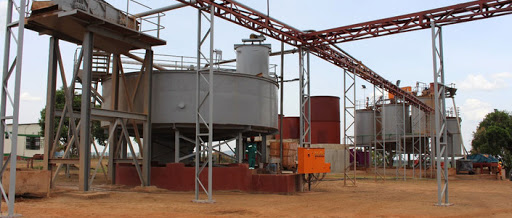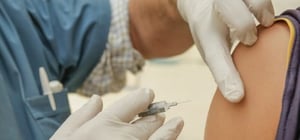Goldplat plc (LON:GDP), the AIM listed gold producer, announced today its preliminary results for the year ended 30 June 2017 (‘FY 2017’).
Operations / Corporate
Significant increase in operating profitability from continuing operations in FY 2017 following the successful turnaround strategy at Kilimapesa Gold Mine, meaning by the end of the last quarter of the year, all operations were operating profitably
Increased gold equivalent production highlights the continued and steady growth of the business – Goldplat produced 42,857 ounces of gold during the year, marking a 13.7% increase on 2016 (2016: 37,666 ounces), which follows a 23.3% increase from 2015
Recovery operations produced 39,449 gold equivalent ounces (2016: 35,661 ounces)
Kilimapesa Mine produced 3,408 ounces of gold (2016: 2,005 ounces) – the increased processing capacity was only seen towards the end of FY 2017 meaning further upside expected with in excess of 5,800oz targeted during FY 2018
Actual sales were 40,285 gold equivalent ounces (2016: 40,763 ounces)
34,112 gold equivalent ounces sold for own account (2016: 27,538 ounces)
6,173 gold equivalent ounces transferred to clients (2016: 13,225 ounces)
Committed to maintaining active growth strategy to build production and profitability:
Gold recovery:
Work well advanced to increase geographical reach, by establishing Ghana as an international recovery hub, with material already being imported from elsewhere in Africa and South America and opportunities identified in North America
Opportunity to diversify metal focus – platinum group metals trials continuing in South Africa
Potential to maximise environmental value by offering mining “clean-up” services processing by-products with contaminants such as mercury – investigating a major project with the Ghanaian Government to assist in the clean-up of artisanal mining tailings
Primary mining:
Focussed on driving increased production at Kilimapesa
Targeting expansion by considering opportunities to gain interests in producing or near-production assets
Non-core exploration portfolio:
TSX quoted Ashanti Gold Corp has the option to earn up to 75% of Goldplat’s interest in the Anumso Gold Project in Ghana by expending US$3million on exploration work at the project
Strategic decision to write off Nyieme Gold Project in Burkina Faso having found the project to be too small scale to be economically viable
Matthew Robinson appointed as Chairman – bolsters the experienced management team
Financials
140% increase in operating profit from continuing operations to £2,910,000 (2016: £1,212,000)
43% increase in profit before tax from continuing operations to £2,836,000 (2016: £1,988,000)
Strong performance continues to be reported at the Group’s recovery subsidiaries:
Goldplat Recovery (Pty) Ltd – South Africa – 36% increase in profit after tax to £2,420,000 (2016: £1,777,000)
Gold Recovery Ghana Limited – Ghana – 169% increase in profit after tax to £1,177,000 (2016: £437,000)
Kilimapesa Gold (Pty) Limited reported a net loss of £1,100,000 for the year (2016: loss of £711,000) as the benefits of increased production capacity were only realised during the second half of FY 2017. In FY 2017 revenue increased to £3,150,000 (2016: £156,000), with operating profit achieved towards the end of the year
Nyieme exploration project discontinued and development cost of £955,000 written-off, with no cashflow impact in current period.
Total comprehensive income for the year still higher than comparative year at £1,989,000 (2016: £1,897,000)
Net cash position of £2,650,000 as at 30 June 2017 (£2,056,000 as at 30 June 2016)
Chairman’s Statement
I am pleased to report in my first Chairman’s statement continued growth in profits from operating activities and progress in our strategic objectives. Our revenue generating assets comprise sophisticated precious metal recovery facilities in South Africa and Ghana and gold mining in Kenya. Results from operating activities for the year from continued operations have crucially increased to £2,910,000 (2016: £1,212,000) underpinning the growing strength of our business and in the final part of the year under review all three operations were making a positive contribution to profitability, with our long-term investment in our Kilimapesa Gold Mine in Kenya now starting to produce worthwhile results. This has, accordingly been a very positive year for our Company and I am pleased to report that our growth initiatives are set to continue as we remain focused on further building production and profitability.
Strategically, we continue to seek to diversify; this diversification is in sourcing material for our processing operations, both geographically and in material types, and in the balance between our recovery and our mining activities. Regarding our recovery operations, we have been active in South America and are encouraged by the opportunities for sourcing materials we see there. We are also active in West and East Africa and considering further opportunities in North America.
We have been continuing to invest in the businesses, sustaining and upgrading equipment in South Africa, developing new processing capacities in Ghana and installing the new, higher capacity, processing circuit in Kenya. We have borrowed modestly and conservatively to develop the Kenyan operations but otherwise investment has been financed, as it has now been for many years, from internally generated cash flows. We have shown the discipline to manage our resources and consider investment opportunities with care; if we see compelling opportunities which require additional capital we will of course consider that also.
Your board of directors has seen a number of changes during the period. In October 2016 my predecessor Brian Moritz retired; Brian had been Chairman since the Company’s admission to AIM in 2006 and the Group is grateful for his guidance and enthusiasm over those years. In light of his departure, at the annual general meeting held in October 2016 shareholders elected me to the board. I am delighted to have joined Goldplat at a time of growth, and look forward to stewarding the Company forward to maintain our active development approach in order to create meaningful value. In June 2017 we were pleased to welcome Sango Ntsaluba and Werner Klingenberg to the board. Alongside a distinguished auditing career, Sango has extensive corporate experience in both the public and private sectors and is executive chairman of a diversified investment holding group. Werner is a Chartered Accountant and, having worked in the Group for two years has exemplary knowledge of our Company; we are accordingly delighted he has taken on the role of Goldplat’s Finance Director.
As a Group we aim to engage positively with the governmental, regulatory and community structures where we operate. We believe that we make a significant contribution where we operate, both financially in terms of fiscal contributions, employment, skills upgrading and local purchasing, as well as by operating high standards of environmental and health and safety protocols. There are currently proposed changes in South Africa in relation to the ownership and operation of entities in the mining sector and we will monitor and assess how best to respond as the situation develops.
We have recently instituted a new programme to engage further with our shareholders. In August this year, the executive team hosted a conference call at which shareholders, and potential shareholders, were invited to question management. We were delighted with the response from shareholders and we intend to offer this opportunity regularly in future. Additionally we will be hosting on Goldplat’s website a Q&A document addressing shareholder questions on the Group and its businesses. I therefore urge shareholders to take advantage of this initiative, send us questions you have and participate in the calls.
Running and growing our businesses profitably requires constant and close attention to detail in sourcing, operations and cost control. I would therefore like to acknowledge and thank management, staff and advisors across the Group, in South Africa, in Ghana, in Kenya and in the UK, for all their efforts over the year.
Matthew Robinson
Chairman
Operations Report
Introduction
I am pleased to report that the turnaround in Goldplat continues and good progress has been achieved on all strategic initiatives during FY 2017. The progress of the Group can be summarised by my statements over the past few years: in 2015, I reported that Goldplat had laid the foundations for a turnaround of the Group’s performance and a return to profitability; in 2016 I reported that we had laid the foundations for growth and diversification; now Goldplat is executing the strategy of growth and diversification and expects continued improvements in production and profitability.
With most major capital projects having been completed during the previous year, the three priorities for FY 2017 included a focus on procurement; developing business opportunities in South America and returning Kilimapesa Gold (Pty) Limited (‘Kilimapesa’) to profitability through a processing plant expansion project. I am pleased to report that during FY 2017 the Group has made good progress on all of these strategic priorities.
Major capital projects for FY 2018 include the continued expansion at Kilimapesa as well as the installation of an elution plant at Gold Recovery Ghana Limited (‘GRG’). The Group is also undertaking numerous research projects on the recovery side of our operation, with a view to diversifying processes and products and creating niches in the industry so as to ensure continued competitiveness. Some of these projects may develop to the point during FY 2018 where capital is required for further development.
Areas of Strategic Focus
With the three areas of strategic focus identified for FY 2017 proceeding well and ongoing, the following additional strategic areas of priority were identified during the year:
With the processing plant expansion at Kilimapesa progressing well, the focus is now to ensure that the underground operations produce sufficient, quality ore to fill the milling capacity at the new processing plant.
Changing market dynamics over the past few years have resulted in the mix of profitability at Goldplat Recovery (Pty) Ltd (‘GPL’) evolving to a point where the carbon-in-leach (‘CIL’) circuits now offer the best profitability for this business. The focus therefore is to ensure that sources of appropriate quality material for all of the CIL circuits are secured and strategic stockpiles built up.
At Gold Recovery Ghana Limited (‘GRG’) the carbon processing business remains key. Prospects of procuring sufficient appropriate quality carbon material within Ghana are unpredictable and hence procurement in South America, West Africa and elsewhere in Africa is of utmost strategic importance.
Goldplat is of the opinion that, strategically, production from recovery operations needs to be complemented by production from primary mining and has set a target of building primary mining production to match that of the recovery operations over a three-year period. Whereas there are a lot of assets available on the market, Goldplat is focused on seeking producing, or near-production assets, which are value-accretive to existing shareholders.
Gold Production and Sales
The table below provides a summary of gold and gold equivalent production and sales for FY 2017, with comparisons to FY 2016. During the year overall production was 42,857 ounces (FY 2016: 37,666) and sales and transfers totaled 40,285 ounces (FY 2016: 40,763). Gold and gold equivalent ounces sold on the Group’s own account was 34,112 (FY 2016: 27,538) and that transferred to clients was 6,173 ounces (FY 2016: 13,225).
The increase in gold and gold equivalent production of 13.7% over the year (on 2016) follows a 23.3% increase in FY 2016 on FY 2015 and demonstrates the continued and steady growth of the business. Production grew at all operations with the most notable growth coming from Kilimapesa as a result of the plant expansion project and from GRG, reflecting increased production from sources outside of Ghana. Production at GPL was once again boosted by a large project executed for a large African producer during the year.
| Goldplat Plc | ||||
| Gold Equivalent Oz Reported | ||||
| Jun-17 | ||||
| Goldplat Plc Consolidated | Year ending | Year ending | Year ending June 2016 | Year ending June 2016 |
| Jun-17 | Jun-17 | Equivalent Gold | Equivalent Gold | |
| Equivalent Gold | Equivalent Gold | kg | oz | |
| kg | oz | |||
| Gold Equivalent Production | ||||
| Goldplat Recovery | 915 | 29,418 | 895 | 28,778 |
| Gold Recovery Ghana | 312 | 10,031 | 214 | 6,883 |
| Kilimapesa Gold | 106 | 3,408 | 62 | 2,005 |
| Total | 1,333 | 42,857 | 1,171 | 37,666 |
| Gold Equivalent Sold | ||||
| Goldplat Recovery | 702 | 22,570 | 516 | 16,575 |
| Gold Recovery Ghana | 259 | 8,327 | 279 | 8,964 |
| Kilimapesa Gold | 100 | 3,215 | 62 | 1,999 |
| Total | 1,061 | 34,112 | 857 | 27,538 |
| Gold Equivalent Transferred | ||||
| Goldplat Recovery | 192 | 6,173 | 411 | 13,225 |
| Total | 192 | 6,173 | 411 | 13,225 |
| Gold Equivalent Sold and Transferred | ||||
| Goldplat Recovery | 894 | 28,743 | 927 | 29,800 |
| Gold Recovery Ghana | 259 | 8,327 | 279 | 8,964 |
| Kilimapesa Gold | 100 | 3,215 | 62 | 1,999 |
| Total | 1,253 | 40,285 | 1,268 | 40,763 |
Goldplat’s Recovery Operations
Goldplat recovers precious metals, primarily gold and silver but also platinum group metals (‘PGM’s’), from by-products of the mining industry and gains its competitive advantage from a combination of the diversity and flexibility of its treatment circuits, which make possible the recovery of metals and concentrates from these by-product materials, the strategic geographic locations of the Group’s plants, and the extensive depth of knowledge and experience of its longstanding team.
Goldplat sources by-products from the mining and related industries. These include coarse and fine carbon, woodchips, rubber and steel mill liners, grease, concentrate bags, surface materials and rock dumps. The Group also assists in plant clean-up operations. These materials typically present an environmental risk and cost to producers but can become a source of precious metals and revenue when processed by Goldplat. Clients include most of the significant gold producers in South Africa and Ghana as well as numerous producers from elsewhere in the world and an increasing number of PGM producers, and a number of refineries requiring the processing of concentrate materials prior to final refining as bullion.
Goldplat Recovery (Pty) Ltd – South Africa
GPL is a well-established operation based near Johannesburg in South Africa, serving clients as a Responsible Gold Producer, fulfilling the requirements set out by the London Bullion Market Association. The Company’s facilities include crushing, milling, thickening, wash plants, CIL, elution, incineration, flotation, spiralling and shotblasting.
During FY 2017 GPL produced 29,418 ounces of gold and gold equivalent (FY 2016: 28,778) of which 22,570 ounces were produced for its own account (FY 2016: 16,575) and 6,173 ounces were transferred to clients (FY 2016: 13,225).
Sourcing of material remained an area of strategic focus at GPL during FY 2017. The mining industry in South Africa remains under pressure and closure of mining operations with consequent reduction in production took place throughout the year and is expected to continue. The major impact to date has been on the gold mines, with this gradual decrease in gold production resulting in a decrease in availability of by-product material for GPL. Goldplat believes that its “base” production level from traditional South African sources is around FY 2015 levels of 22,000 ounces of gold and gold equivalents. In FY 2016 the Rand Refinery silver sulphide tolling project added significantly to this base level and in FY 2017 a large one-off batch of carbon from a new African client was processed. In order to keep production levels at around the 29,000 ounces of gold and gold equivalent level, GPL has to ensure that it sources and processes similar large one-off by-product projects every year.
With production from the CIL circuits becoming more strategically important than from the by-product streams, focus is now on procuring long-term supplies of material to feed these circuits. Numerous projects are underway in partnership with existing clients and a large strategic batch of material was procured during FY 2017. Metallurgical test work is being conducted on this material to improve recovery rates and profitability. As a result of the strengthened strategic sourcing team, smaller precious metal producers are now also being visited to source by-products in addition to those received from the large mining companies. Volumes at the smaller operators are lower compared to the larger mining companies but increases our footprint as service provider of choice.
With all major capital projects having been completed during FY 2016, capital expenditure during the year was primarily on sustaining capex. During the year the cyclone sections and kiln seals on one of the rotary kilns were replaced and a new mill was installed in the high grade CIL section.
Metallurgical test work and pilot tests on the stock dam/tailings storage facility material continue; this has a JORC-compliant resource (refer to the announcement of 29 January 2016) of 81,959 ounces of gold, 216,094 ounces of silver and 193,276 pounds of U3O8 (uranium oxide) and accordingly we believe it has significant value potential. Alongside this, the process of securing the West 3 Pit for deposition of tailings continues but with the different interests of the various stakeholders and the changing regulatory environment, the approval process is taking longer than initially anticipated. The Company remains confident that the logistical and regulatory issues will be overcome and the pit will be secured.
No resolution regarding the Rand Refinery dispute was reached during the year. Goldplat now has working arrangements with four different refiners with each product having potential for refining at one of at least three places, including GPL itself. Goldplat is confident that the previous single refiner risk has been mitigated and proceeded with legal action against Rand Refinery on 11 September 2017.
On 15 June, 2017 the Broad Based Socio-Economic Empowerment Charter for the South African mining and minerals industry, 2017, (the ‘2017 Charter’) was announced and gazetted in South Africa. The 2017 Charter aims to introduce far-reaching, new, and in some cases, radical measures and requirements on the industry. GPL is compliant with the preceding Charter, and if the 2017 Charter is implemented, certain changes will be required to maintain compliance, primarily in respect of: (i) the increased mandatory Black Economic Empowerment shareholding which is currently set at 26%, but is proposed to be increased to 30%, and (ii) in the required make-up of management demographics. Further to an interdict application brought by the Chamber of Mines against implementation of the Charter, the Minister of Mineral Resources has undertaken not to implement or apply the provisions of the 2017 Charter pending judgment on the interdict. Goldplat and GPL will monitor this issue and will keep shareholders informed as to progress and the possible impact on the Company as the process unfolds.
Gold Recovery Ghana Limited – Ghana
GRG’s gold recovery operation, which had a tax-free status until December 2016, and a favourable tax rate thereafter of 15%, is located in the free port of Tema in Ghana. Processing facilities include a spiraling section, filter presses, an incinerator and a shotblast facility, used to recover gold from mill liners. Concentrates produced at GRG are exported to GPL or to one of the Group’s refinery partners. Most of the region’s major gold producers and a number of smaller operations have contracts with GRG for the processing of their by-products, which include fine carbon, fine carbon sludges, steel and rubber mill liners, wood chips, slag, scaling and grease.
During FY 2017 GRG produced 10,031 ounces of gold (FY 2016: 6,883) of which 8,327 ounces were produced for its own account (FY 2016: 8,964).
With sources of material from within Ghana continuing to deplete for various reasons, focus during the year remained on sourcing from outside of the country. Momentum in this regard is picking up with contracts secured from elsewhere in Africa as well as South America. The Company has been sourcing and shipping material on a regular basis from various individual suppliers in South America since the second half of 2016 and good progress was made on contract negotiations during FY 2017. The first significant recurring contract was signed with initial shipments of 360 tonnes of carbon underway to Ghana and shipments of rubber mill liners being finalised.
A complete, second-hand 3-tonne elution plant was acquired from a producer in South Africa for ZAR 2 million (approximately US$155k). This plant is modular, complete with all ancillary equipment and will more than meet the requirement of the Ghanaian operations. As such, it was deemed a better option than moving an existing 4-tonne plant from GPL to GRG and the purchase of the required ancillary equipment and infrastructure. It is estimated that the final cost of installation will be in the order of US$1m, compared to the initial estimate of US$2m for the plant from GPL. During the last quarter of FY 2017, the acquired elution plant was dismantled, moved to GPL for refurbishment and is now in the process of being shipped to Ghana. Installation and commissioning is expected to be significantly quicker than per previous plans, with commissioning now planned for the end of December 2017, six months ahead of the milestone date stipulated by the Ghanaian Government in accordance with the Company’s gold license renewal terms.
A third fluidised bed incinerator, which was purchased second-hand from an operator in Tanzania is currently being transported for shipment to GRG.
Focus was put into improving security at the plant and also in processing the large stockpiles of low-grade material. These projects are ongoing and contribute to ensuring space and a secure environment for planned increased production at GRG in the future.
GRG is investigating a major project with the Ghanaian Government to assist in clean-up of artisanal mining tailings. The Company is conducting extensive sampling programmes to assess both gold as well as contaminant (mainly mercury and cyanide) content and is simultaneously investigating the most efficient processing methods so as to recover gold and deal with contaminants in an environmentally acceptable manner (in compliance with acceptable global standards).
Goldplat’s Mining and Exploration
Kilimapesa Gold (Pty) Limited – Kenya
Kilimapesa is a producing gold mine located in South Western Kenya. The mine is located in the historically productive Migori Archaean Greenstone Belt and has a total resource (refer to the announcement of 12 December 2012) of 8,715,291 tonnes at 2.40 g/t of gold for a total of 671,446 ounces of gold at a cut-off of 1 g/t.
Kilimapesa made operational profits during the last two months of FY 2017 the first time in the ten years since acquisition. This has been made possible primarily due to the substantial completion during the year of an additional processing plant (‘Plant 2’), but also as a result of continued cost cutting and process efficiency improvements across the operation.
Kilimapesa produced 3,408 ounces of gold during the year (FY 2016: 2,005 ounces), of which 3,215 ounces of gold were sold during the period (FY 2016: 1,999 ounces). Significantly, 1,254 ounces of gold was produced during the last quarter of the year and an annualised production rate of roughly 5,800 ounces of gold was achieved in the last two months of the year – a rate which is sustainable with current infrastructure.
During FY 2016 it was decided by the Board to invest in the expansion of processing capacity at Kilimapesa, at an overall capital expenditure in the order of US$2 million. During that year a CIL plant from GRG was deconstructed and shipped to Kenya for installation and commissioning at Kilimapesa, and two matching second-hand ball mills were also acquired in South Africa for installation at the mine. These would be used to construct the new Plant 2, and during 2017 the site for construction was chosen to be near to Kilimapesa Hill, from which the mined ore would be sourced. All necessary regulatory approvals were also obtained during the period.
During 2017 Goldplat put in place a three stage development plan to construct Plant 2 and build production. Stage One included the installation of a generator, the first of the two ball mills, a concentrator facility, thickener and six CIL tanks from GRG, as well as the construction of a borrow pit for initial tailings deposition and the site preparation and key cut for the final tailings storage facility (‘TSF’). As the crusher circuit was planned for Stage Two, a stockpile of fine ore was created during Stage One construction to facilitate commissioning and production during Stage Two installation. Stage One was commissioned by the end of December 2016 with a mill throughput rate of 60 tonnes per day being achieved as per plan, using uncrushed and partially crushed ore.
Up to this point the plant expansion had been funded out of internally-generated operating cash flows from the Group. With stage one of the expansion commissioned, the Company decided to arrange a loan facility of up to US$2 million (the “Scipion Loan”) to recapitalise the Group’s subsidiaries that had financed the work to date, and to fund the expenditure of Stage Two of the processing plant expansion.
During the second half of FY 2017 Stage Two was substantially completed, which included installation of the crusher section, associated feed belts and bins, classifier and three additional larger CIL tanks. Two additional borrow pits were constructed to allow tailings deposition of up to a year before completion of the final TSF. Complete commissioning was delayed by a few months due to hold-ups in delivery of key materials, primarily steelwork associated with safety. Notwithstanding these delays, during the last two months of FY 2017 Plant 2 was successfully processing at a mill throughput rate of the planned 120 tonnes per day.
Stage Three of the plant expansion includes the installation of the second mill, an additional thickener and three additional CIL tanks. This stage will only commence once management is confident of sustained profitability and once the Scipion debt facility has been substantially repaid.
The old processing plant (‘Plant 1’) continued producing throughout and with more flexibility better efficiencies were achieved from this plant. Plant 1 is now processing primarily tailings sourced from artisanal operations in nearby areas. Better management of the TSF at Plant 1 has increased the available life of this facility to around a year (from the 3-6 months at the beginning of FY 2017).
During the year the mining focus was on creating capacity at Kilimapesa Hill underground to produce enough ore of appropriate grade to satisfy the throughput requirements of Plant 2. Focus was on developing reef drives and raises so as to delineate profitable mining blocks. A mechanical loader was acquired to facilitate ore handling in the cross cuts and reef drives and a Kempe core drilling machine was acquired to assist in understanding the orebody, and aid in strategic planning of mining operations. Commissioning of this machine was not completed during the year as the required generator had not yet been delivered. By year end, production from the Kilimapesa underground had not yet reached planned levels and throughput at Plant 2 was being met by the addition of stockpiled material and artisanal tailings.
A decision was taken during the year to install grid power to Plant 2. Required authorisations and procurement of equipment was still in progress at the end of the year and this is expected to be completed in H1 of FY 2018.
During FY 2017, significant progress was made at Teng Teng mine. A second outlet was established, the shaft was deepened to facilitate more efficient ore loading, and significant underground exploration was completed. Due to a breakdown of the compressor and low priority of allocation of funds for repair, Teng Teng exploration was temporarily halted for the last few months of FY 2017. Activities will recommence as soon as the compressor has been repaired. It is expected that the process of applying for conversion of the Teng Teng area into a mining license will commence during FY 2018.
Subsequent to the year end, Kenyan National elections were held during August 2017. The Cabinet Secretary for Mining and the Governor of Narok County, where our project is located, remain unchanged which is important for smooth relations in the country as Goldplat and Kilimapesa management have developed very good working relationships with these individuals. The result of the Presidential election was subsequently declared null and void by the High Court and a new election process has to be completed within sixty days from the day of the Court ruling, 1 September 2017.
Anumso Gold Project – Ghana
Goldplat has a 90% interest in Anumso Gold Limited (‘Anumso’), which is the holder of a ten-year renewable mining lease for gold and associated minerals covering an area of 29 sq. km. The project is located in the prospective Amansie East and Asante Akim South Districts of the Ashanti Region of the Republic of Ghana and has a current JORC compliant resource (refer to the announcement of 12 December 2012) of 166,865 ounces of gold at 2.04g/t.
During FY 2016, Goldplat entered into an earn-in option agreement with Ashanti Gold Corp. (‘Ashanti’) (formerly Gulf Shore Resources Ltd), which provides Ashanti with the exclusive option to earn 75% of Goldplat’s interest in Anumso (67.5% of the overall project interest) in two instalments by expending an aggregate of US$3 million on exploration on the project. In March, 2017, Ashanti exercised its initial option which triggered the initial option period, during which a 51% share of Goldplat’s interest will be earned through expending US$1.5 million over 18 months. Ashanti is obliged to either expend US$1.5 million on the project within the initial option period, or pay the deficiency to Goldplat.
Should Ashanti meet the expenditure condition within the Initial Option Period and receive 51% of Goldplat’s interest in the Anumso (45.9% of the overall project interest), it will have the option to earn an additional 24% share of Goldplat’s interest (21.6% of the overall project interest) by expending an additional US$1.5 million in the following 12 month period, or by paying the deficiency to Goldplat.
By the end of FY 2017 Ashanti had spent an aggregate of US$750,000. Work included setting up an exploration camp; establishing relationships with local chiefs and community; the analysis of historic core; core intersections submitted for metallurgical testing; completion of a 20-hole reverse circulation (‘RC’) drill programme; continued analysis of drill results; and a comprehensive soil sampling programme (1,300 soil samples) over the West and East Banka conglomerate. Results of metallurgical test work and assay results of soil samples are awaited.
Nyieme Gold Project – Burkina Faso
The 246 square km Nyieme Gold Project is located some 270 km southwest of Ouagadougou near the town of Dano on the prospective Birimian Greenstone Belt in southern Burkina Faso. The project has a JORC-compliant resource (refer to the announcement of 12 December 2012) totaling 1,395,000 tonnes at 2.06 g/t gold for 92,598 ounces at a cut-off grade of 1.0 g/t gold for all categories. The exceptional 3-year extension which was granted on 29 September, 2014 expires in October 2017. The Company has no intention to apply for a further extension or a renewal as previous work at the project found it to be of too small a scale to be viable and the Company does not wish to commit any further capital on exploration at this project. A decision has been taken by the Board to fully write-off the value of the Nyieme Gold Project during FY 2017. The value of this write-off in Goldplat’s Statement of Profit and Loss and other Comprehensive Income for the year ended 30 June 2017 is £955,000.
Outlook
Goldplat is now operating profitably at all of its operations and the Board believes performance should continue to improve during FY 2018. Growth in the recovery business is expected to come from GRG as a result of initiatives to procure material from West Africa and South America, as well as the commissioning of the elution plant at GRG. The project being assessed with the Ghanaian Government to clean up artisanal tailings could potentially turn into a large opportunity for GRG. If successful, this project will not only be profitable and contribute to growth in GRG, but it will pave the way for once again processing artisanal tailings and for processing by-products with contaminants such as mercury – both from within Ghana as well as from international sources, thus creating new revenue opportunities. Subsequent to the year-end, a pilot plant for the processing of artisanal tailings was procured at minimal cost and is expected to be in production in the second quarter of FY 2018. We expect production and profitability at GPL to remain at current levels albeit that the focus will shift to the more profitable CIL products locally and procurement of additional by-products from outside of South Africa. We initiated legal proceedings against Rand Refinery on 11 September 2017 and cannot predict how long such proceedings might last. Goldplat remain confident that all monies owed to GPL by Rand Refinery will be recovered.
Growth from mining operations will be focussed on the Kilimapesa expansion project. Subsequent to the year-end, the crusher section at Plant 2 was commissioned and the plant is consistently exceeding the planned 120 tonnes per day throughput target, and managing closer to 160 tonnes per day regularly. A decision has been taken to install the second mill at Plant 2 whether or not a decision is taken to proceed with Stage Three to provide back-up to the first mill and potentially additional production capacity. The plan for the year is to get to a point where only ore from Kilimapesa Hill underground is processed at Plant 2 with artisanal tailings being processed at Plant 1. Production exceeding 5,800 ounces is expected during FY 2018.
In addition to Kilimapesa, Goldplat will continue to seek out opportunities to increase primary production from new sources. Goldplat recognises that growth from recovery operations will be slower and more difficult than the potential to grow the mining business. The current market presents many opportunities for acquisitions of assets, joint ventures, partnerships and corporate deals. Goldplat does not intend to enter into exploration, and will prefer to gain interests in producing or near-production assets, preferably in Africa.
Conclusion
I would like to take this opportunity to thank our Goldplat employees, advisors, fellow directors and shareholders for their support as we embark upon our growth and diversification strategy in FY 2018. I look forward to working with all of you as we implement this strategy. I would like to welcome Matthew Robinson, Sango Ntsaluba and Werner Klingenberg who joined the Goldplat Board during the year as Chairman, Non-Executive Director and Finance Director respectively. I would also like to thank Ian Visagie, who has changed his Board role during the period, now assuming the role of Executive Director; he remains an integral part of the executive management team. I would like to take this opportunity to thank him for the incredible contribution he has made to Goldplat over the years as founder, CFO and acting CEO, and particularly his immense contribution to the turnaround of the businesses over the past couple of years.
Gerard Kisbey-Green
Goldplat Plc Chief Executive Officer







































